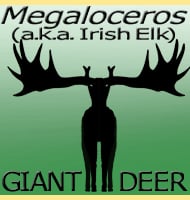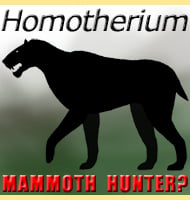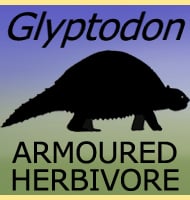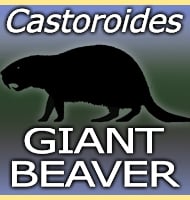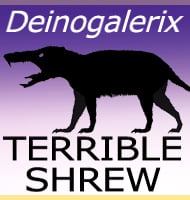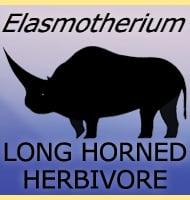


Ursus spelaeus
(Cave Bear)
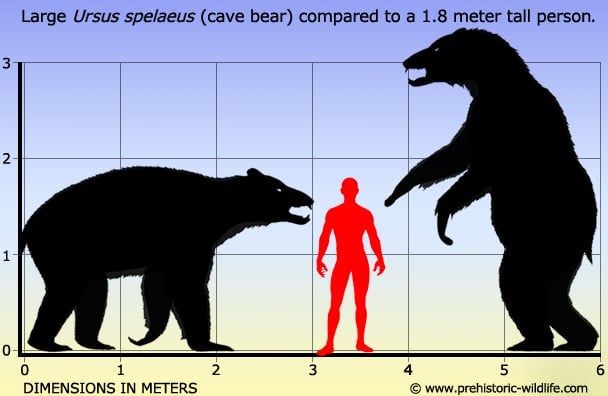
Name: Ursus
spelaeus
Phonetic: Ur-sus spel-ay-us.
Named By: Johann Christian Rosenmüller - 1974.
Classification: Chordata, Mammalia, Carnivora,
Ursidae.
Species: U. spelaeus.
Diet: Primarily a herbivore, fossil evidence
indicates the occasional intake of meat suggesting that it was an
omnivore.
Size: Depending on gender, 2.1 - 3 meters
long. Males were larger than females with weights between 400-500
kilograms. Females ranged between 225-250 kilograms.
Known locations: Across Europe including western
Russia, down to the Northern areas of the middle east.
Time period: Pleistocene.
Fossil representation: So numerous that no one is
sure for certain exactly how many remains exist.
Ursus
spelaeus, better known as the
cave bear is by
far one of the most common Pleistocene mammals in the fossil record,
thanks mainly due to its behaviour of frequenting caves. In fact the
fossils of Ursus spelaeus are so numerous that in
World War I the
German army used them as a source of phosphates.
The
huge numbers of cave bear
fossils in caves that have been documented to represent thousands of
individuals to a single cave strongly suggests that this bear regularly
spent time in caves, perhaps returning to rest after foraging.
Bears that we know today by contrast only frequent caves during the
hibernation period and sleep outdoors during the warmer months. The
immense number of Ursus spelaeus fossils in certain
caves has also led
to the theory that these bears may have actually lived in social
groups, although in depth study of the layers and dating has
suggested that the remains are of single individual bears building up
over the course of the Pleistocene period. As older remains became
buried by sediment and fossilised they would have been of no
nutritional value to anything and would have been left alone to
accumulate, giving the impression of several bears living together
rather than just one or two.
Cave
bears have long been
thought to be herbivorous animals, meaning that they only ate
plants. Key evidence for this comes from the lack of premolar teeth
that are usually absent in herbivores resulting in a gap between the
forwards canines and rear molars called a diastema. Isotope analysis
has also yielded low amounts of carbon-13 and nitrogen-15 which are
usually found in high concentrations in carnivores. Counter to the
strictly herbivorous diet theory however is the presence of some
fossils that do have elevated levels of nitrogen-15, as, well as
tooth wear associated with the gnawing of bones. Additionally some
cave bear fossils also have tooth marks on them that seem to have been
caused by others of their species. Not only does this suggest that
cave bears occasionally ate meat, they may have scavenged the dead
bodies of other cave bears that had died in caves. This is why Ursus
spelaeus is today considered by most to have been an
opportunistic
omnivore that relied mostly upon eating plants, but would also
supplement its diet with occasional meat when it was able to.
As
one might expect cave
bears were most common in areas that had large amounts of caves,
particularly limestone that would have had caves carved out by water
over several eons. As such cave bears lived in ecosystems that were
between lowland plains and high level mountains that would have had a
greater variety of trees and vegetation growing in them. Aside from
offering a greater variety of food, a habitat preference such as this
suggests that Ursus spelaeus did not compete with
other European
megafauna such as the woolly rhino and the woolly mammoth since they
inhabited more open areas. Cave bears could also range across most of
Europe, settling where they encountered suitable habitats, because
the lower sea levels meant that marine boundaries such as the English
Channel and North Sea did not exist.
A
greater determining factor
in the range of cave bears was the amount of glacial cover, something
that would have expanded and receded over varying periods. Ursus
spelaeus individuals from both milder and harsher times are
known,
with the individuals present in harsher times growing slightly larger
than the bears that lived in slightly warmer times. This is a simple
strategy where growing bigger creates a greater level of outer
insulation while the total surface area of the body still increases but
at proportionately less amount than the total body mass. This has
been repeated and documented many times for different mammals that live
in colder climates that all grow proportionately bigger that their
closest related genera, perhaps the most relevant example here being
the polar bear (Ursus maritimus) which does well
in arctic
conditions, but has been seen to overheat when kept in zoos in warmer
climates.
Returning
to the large
collections of remains mentioned above, it’s clear that large
numbers of Ursus spelaeus died in caves, but this
needs further
investigation. Because the remains of cave bears accumulated over
tens of thousands of years it is easy to immediately discount the
possibility of cave ins, as such an event would have only trapped
one bear and then prevented others from entering. One widely accepted
theory is that cave bears that did not eat enough food during the
summer months to build up their fat reserves ended up starving to death
as they slumbered. Even today animals that rely upon hibernation to
last out the colder winter are vulnerable in times where plants do not
grow or produce as much sustenance as they usually do, and back in
the Pleistocene when ice sheets were toing and froing across Europe
food would have been even more unpredictable from year to year.
More
in depth study of some
cave bear remains has revealed that bone disorders such as rickets,
periostitus and osteomyelitis were quite common including other
ailments such as the presence of tumours. Although not necessarily
fatal to the individuals these bones belonged to, they would have
impeded their ability to forage, slowly bringing the animal down to
the point where it could no longer support itself. In these weakened
states its thought that cave bears may have even fallen as prey to cave
hyenas as well as even the European cave lion, that otherwise may
have given a healthy bear in the prime of its life a wide birth.
Ultimately
as a species,
cave bears seem to have succumbed to the effects of habitat loss, as
by only living in caves these bears would have only ever had a set
amount of areas available to them. However as the Pleistocene was
reaching its final stages, Neanderthals were beginning to become more
common, and these primitive people also used caves for shelter.
Inevitably one species would have to give way, and it was the cave
bear that lost out to the greater numbers and intelligence of
Neanderthals.
However
despite the fact that
they seem to have taken over, Neanderthals also seem to have held
cave bears in very high regard. There are several burial sites in
Europe where the remains of several bears have been assembled in pits
and then covered with stone slabs. Perhaps the most famous site is
Drachenloch, Switzerland where seven cave bear skulls are arranged to
face the front of the cave, while six more are placed in recessed
notches in the cave wall further in. Further remains were found
bundled together, along with a skull of a three year old juvenile
bear that had had its cheek pierced by the leg bone of another juvenile
bear. Although some researchers claim that these are natural
occurrences, there are a great many other who believe that remains
like these are those of an ancient bear cult. How and why bears would
be worshipped is uncertain, but it could be for anything from a
totem animal, to a guardian of the caves against intruders, to
maybe even a ward against other cave bears wandering in to Neanderthal
settlements.
Further reading
- On the phylogeny of Eurasian bears. - Palaeontographica Abteilung A
230: 1–32. - P. Mazza & M. Rustioni - 1994.
- What size were Arctodus simus and Ursus spelaeus
(Carnivora:
Ursidae)? - Annales Zoologici Fennici 36: 93–102. - Per Christiansen -
1999.
- Ancient DNA analysis reveals divergence of the cave bear, Ursus
spelaeus, and brown bear, Ursus arctos,
lineages. - Current
Biology 11
(3): 200–203. - Odile Loreille, Ludovic Orlando, Marylène Patou-Mathis,
Michel Philippe, Pierre Taberlet & Catherine Hänni - 2001.
- Genomic Sequencing of Pleistocene Cave Bears. - Science 309 (5734):
597–599.- James P. Noonan, Michael Hofreiter, Doug Smith, James R.
Priest, Nadin Rohland, Gernot Rabeder, Johannes Krause, J. Chris
Detter, Svante Pääbo & Edward M. Rubin - 2005.
- Comparative dental microwear analysis of cave bears Ursus
spelaeus
Rosenmüller, 1794 and brown bears Ursus arctos
Linnaeus ,1758. -
Scientific Annals, School of Geology Aristotle University of
Thessaloniki (AUTH). Special 98: 103–108. - A. C. Pinto Llono - 2006.
- Prey deposits and den sites of the Upper Pleistocene hyena Crocuta
crocuta spelaea (Goldfuss, 1823) in horizontal and vertical
caves of
the Bohemian Karst (Czech Republic). Bulletin of Geosciences 81(4),
237–276 (25 figures). - Czech Geological Survey, Prague. ISSN
1214-1119. - C. G. Diedrich & K. Zak - 2006.
- Isotopic evidence for omnivory among European cave bears: Late
Pleistocene Ursus spelaeus from the Pestera cu Oase, Romania.- PNAS
105: 100–104. - Michael P. Richards, Martina Pacher, Mathias Stiller,
Jérôme Quilès, Michael Hofreiter, Silviu Constantin, João Zilhão, and
Erik Trinkaus - 2008.
- Reply to Grandal and Fernández: Hibernation can also cause high δ15N
values in cave bears. - Proceedings of the National Academy of Sciences
of the United States of America 105 (11): E15.
doi:10.1073/pnas.0801137105 - Erik Trinkaus & Michael P.
Richards - 2008.
- Extinction chronology and palaeobiology of the cave bear (Ursus
spelaeus). - Boreas 38 (2): 189–206 - M. Pacher & A. J. Stuart
- 2009.
- Ecomorphological correlates of craniodental variation in bears and
paleobiological implications for extinct taxa: an approach based on
geometric morphometrics - Journal of Zoology Volume 277, Issue 1, pages
70–80 - B. Figueirido, P. Palmqvist & J. A. Pérez-Claros - 2010.
- Withering Away - 25,000 Years of Genetic Decline Preceded Cave Bear
Extinction. - Molecular Biology and Evolution 27 (5): 975–978. -
Mathias Stiller, Gennady Baryshnikov, Hervé Bocherens, Aurora Grandal
d'Anglade, Brigitte Hilpert, Susanne C. Münzel, Ron Pinhasi, Gernot
Rabeder, Wilfried Rosendahl, Erik Trinkaus, Michael Hofreiter &
Michael Knapp - 2010.
Random favourites
 |
 |
 |
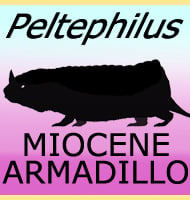 |



